11 Best Horseback Riding Locations in the USA for 2024: The Ultimate Guide
- March 28, 2024
- 0 comment
Explore the 11 Best horseback riding spots in the USA for 2024. From scenic trails to epic adventures, find your perfect ride in our guide. Horseback riding captures the essence of adventure and freedom, offering a unique blend of physical activity, mental relaxation, and a deep connection with nature. Across the United States, diverse landscapes offer a backdrop for this timeless activity, ranging from serene trails through lush forests to dramatic rides along rugged coastlines. As we look towards 2024, the quest for the ultimate horseback riding locations has led us to curate a list that promises unparalleled experiences for riders of all levels.
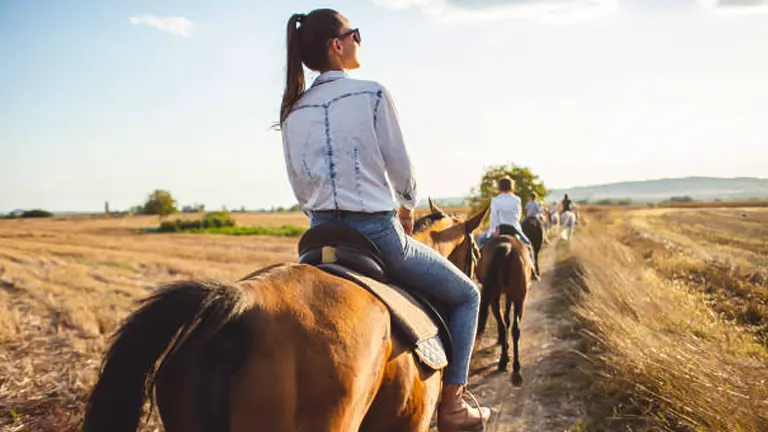
Join us as we gallop through scenic trails, majestic mountains, and hidden gems, unveiling the premier spots for horseback riding enthusiasts to make memories that will last a lifetime.
List of 11 Best Horseback Riding Locations in the USA for 2024
- Big Sky, Montana
- Sedona, Arizona
- Asheville, North Carolina
- Bryce Canyon National Park, Utah
- Valley of the Gods, Utah
- Ocala National Forest, Florida
- The Willamette Valley, Oregon
- Gettysburg National Military Park, Pennsylvania
- Maui, Hawaii
- Custer State Park, South Dakota
- Shenandoah National Park, Virginia
The Significance of Horseback Riding in 2024
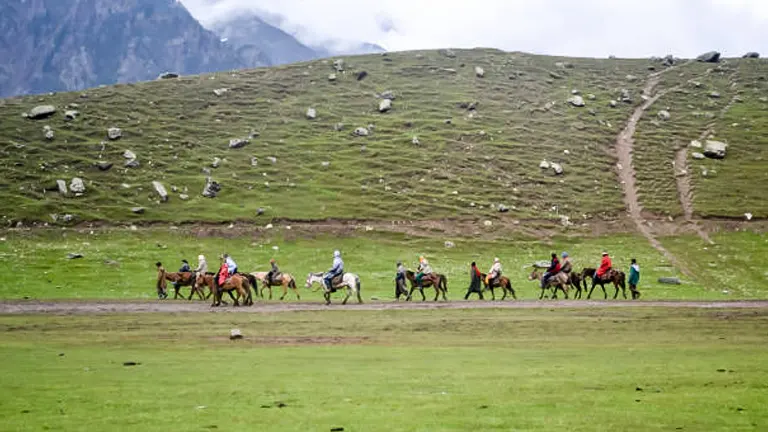
The past few years have reignited our appreciation for the great outdoors. Horseback riding, in particular, stands out not only as a way to explore the beauty around us but also as a means to foster well-being. Engaging with horses and nature offers therapeutic benefits, including stress reduction, improved mental health, and physical fitness. As we move into 2024, embracing these outdoor activities is more important than ever, providing a respite from the digital world and strengthening our connection to the environment.
How We Selected the Best Locations
In compiling our list of the 11 best horseback riding locations in the USA for 2024, we prioritized a blend of scenic beauty, trail quality, accessibility, and the presence of unique features that set each location apart. Consultations with equestrian experts, local guides, and rider reviews played a crucial role in our selection process, ensuring that each destination offers a memorable and rewarding experience.
11 Best Horseback Riding Locations in the USA for 2024
1. Big Sky, Montana
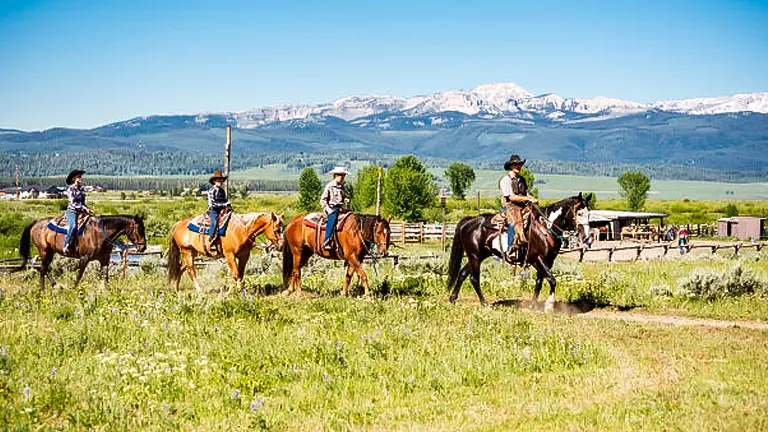
Nestled in the heart of the Rocky Mountains, Big Sky, Montana, offers a dramatic backdrop for horseback riding adventures, characterized by its crisp, clean air and a climate that showcases all four seasons. The area boasts lush summers, colorful autumns, snowy winters, and vibrant springs, making it a picturesque setting year-round. The trails wind through expansive meadows, dense pine forests, and alongside rushing rivers, offering panoramic views of the towering peaks. This varied terrain is suitable for all skill levels, from gentle paths for beginners to challenging routes for the more experienced. Riders have the chance to encounter wildlife, such as elk and deer, and the area is known for its breathtaking sunset rides.
- Location: Southwest Montana, 50 miles from Bozeman.
- Size: Extensive trail network across diverse terrains.
- How to Get There: The closest major airport is Bozeman Yellowstone International Airport. From there, visitors can rent a car or use shuttle services to reach Big Sky.
- Fees/Rental: Horseback riding tours start at $85 for a 1-hour ride, with options extending to around $250 for full-day adventures. Various ranches and stables offer equipment rental and guided tours.
- Best Time to Visit: The ideal time to visit is from late spring through early fall, which offers the best trail conditions and weather.
- Suitable for: The area caters to all levels, from beginners to experienced riders.
- Additional Tips: Advance booking is highly recommended, especially during peak seasons. Visitors should bring sunscreen, water, and wear appropriate clothing to adapt to the changing weather conditions throughout the day.
2. Sedona, Arizona
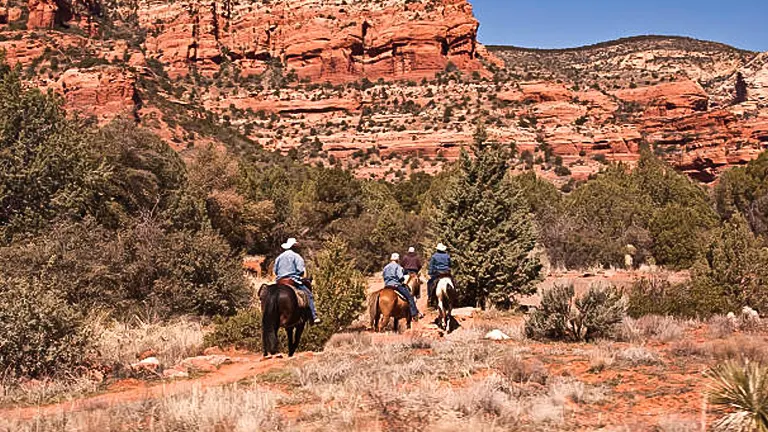
Sedona, set in the heart of Arizona’s desert landscape, presents a starkly different backdrop for horseback riding with its iconic red sandstone formations and mild climate. The trails here offer a journey through mesmerizing red rock landscapes, steep canyons, and serene desert scenery, making it a must-visit for those looking to experience the beauty of the American Southwest.
- Location: Northern Verde Valley region of Arizona.
- Size: Numerous trails covering the expansive red rock formations.
- How to Get There: The nearest major airport is in Flagstaff, about an hour’s drive from Sedona. Phoenix Sky Harbor International Airport is also an option, located approximately two hours away by car.
- Fees/Rental: Horseback riding tours in Sedona can range from $75 to $200, depending on the length and exclusivity of the tour. Equipment and guided tours are readily available through local outfitters.
- Best Time to Visit: Spring and fall offer the most pleasant weather for outdoor activities, though Sedona’s climate allows for year-round riding opportunities.
- Suitable for: Riders of all experience levels, with trails ranging from easy to challenging.
- Additional Tips: Sedona is known for its outdoor adventure opportunities, so consider combining your horseback riding trip with hiking or mountain biking to fully experience the area’s natural beauty.
3. Asheville, North Carolina
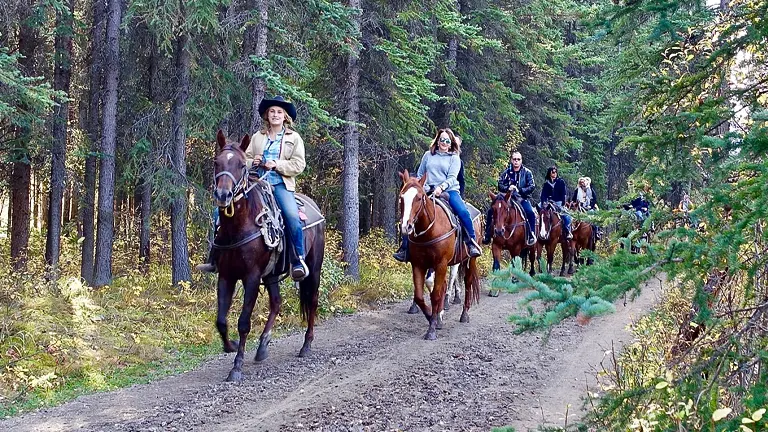
Asheville lies in the heart of North Carolina’s Blue Ridge Mountains, offering lush, forested trails and breathtaking mountain vistas. This area is renowned for its vibrant display of autumn foliage, but every season offers its own charm, from blooming wildflowers in spring to snow-dusted paths in winter.
- Location: Western North Carolina, in the Blue Ridge Mountains.
- Size: Access to hundreds of miles of trails in the surrounding national forests.
- How to Get There: The Asheville Regional Airport is the closest, with several direct flights from major cities. Alternatively, Charlotte Douglas International Airport is about two hours away by car.
- Fees/Rental: Pricing for horseback riding excursions around Asheville starts at around $65 for an hour-long ride, with half-day and full-day adventures available for a higher fee. Many stables offer a variety of tour packages.
- Best Time to Visit: Late spring through early fall for the most comfortable weather and trail conditions, with autumn being particularly spectacular for leaf-peeping.
- Suitable for: All skill levels, with a wide range of trails that cater to beginner and advanced riders alike.
- Additional Tips: Asheville’s rich cultural scene is worth exploring after your ride. The city is known for its vibrant arts community, historic architecture, and culinary delights.
4. Bryce Canyon National Park, Utah
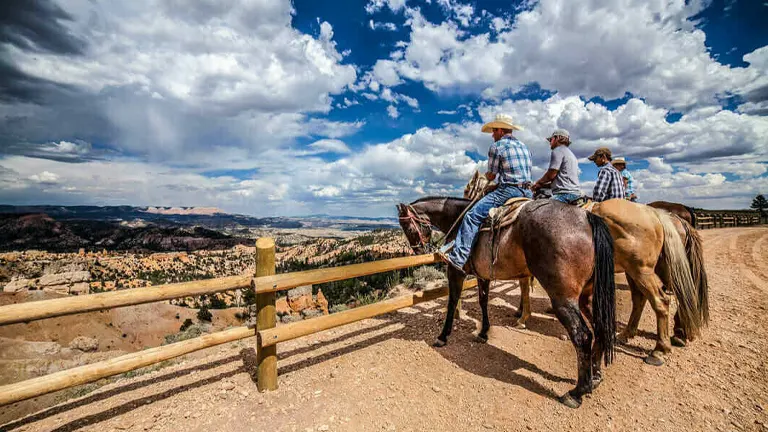
Bryce Canyon National Park, known for its extraordinary landscapes, is a haven for horseback riders seeking adventure among the park’s famous hoodoos—tall, thin spires of rock that protrude from the bottom of arid basins. The park offers a unique riding experience through its otherworldly geological formations and panoramic vistas.
- Location: Southern Utah.
- Size: The park covers 56 square miles of high-altitude terrain, with trails specifically designated for horseback riding.
- How to Get There: The nearest major airport is Las Vegas McCarran International, about a four-hour drive. Closer regional airports include Cedar City and St. George.
- Fees/Rental: Guided horseback riding tours are available within the park, with fees starting around $65 for a two-hour ride. Longer excursions, including half-day and full-day rides, are also available.
- Best Time to Visit: Late spring to early fall offers the most comfortable weather for riding. Summer mornings tend to be cooler, ideal for longer rides.
- Suitable for: Intermediate to experienced riders, due to the park’s rugged terrain and elevation changes.
- Additional Tips: Remember to pack water and sun protection, as the high altitude and exposed trails can lead to quicker dehydration and sunburn.
5. Valley of the Gods, Utah
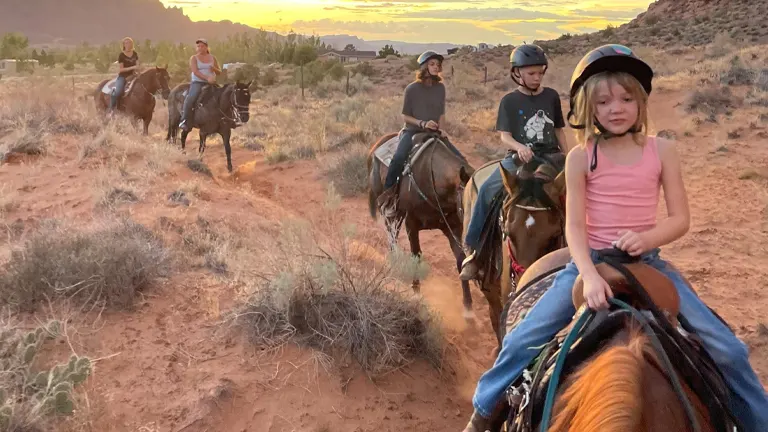
Not far from the more crowded Monument Valley lies the Valley of the Gods, offering secluded and serene landscapes filled with towering sandstone formations. This lesser-known gem provides a tranquil escape on horseback, with trails weaving through vast, open spaces and past awe-inspiring rock structures.
- Location: Southeastern Utah.
- Size: The valley covers a wide expanse of desert landscape with numerous trails to explore.
- How to Get There: The closest airports are in Cortez, Colorado, and Farmington, New Mexico, each about a two-hour drive away. A high-clearance vehicle is recommended for accessing trailheads.
- Fees/Rental: Horseback riding in the Valley of the Gods is generally self-guided, so bring your own horse or arrange for a rental from nearby stables, which may offer guided tours.
- Best Time to Visit: Spring and fall are ideal, with mild temperatures and less chance of rain.
- Suitable for: All skill levels. The terrain is mostly level, making it accessible for beginners, yet the scenery is equally rewarding for experienced riders.
- Additional Tips: The area is remote, with few services, so plan ahead by bringing plenty of water, snacks, and a map or GPS device.
6. Ocala National Forest, Florida

The Ocala National Forest offers a stark contrast to the desert and mountain landscapes typically associated with horseback riding. Here, riders can explore subtropical forests, clear springs, and winding rivers, providing a lush backdrop for rides.
- Location: Central Florida.
- Size: Over 600 miles of trails within 607 square miles of protected forest.
- How to Get There: The closest major airports are in Orlando and Gainesville, with the forest accessible by car from both cities.
- Fees/Rental: Many trailheads are free to access, though some may require a nominal fee. Horse rental and guided tour prices vary by provider.
- Best Time to Visit: Fall through spring to avoid the summer heat and humidity.
- Suitable for: Riders of all levels, with trails ranging from easy, well-marked paths to more challenging routes.
- Additional Tips: Keep an eye out for wildlife, including deer and various bird species. Insect repellent is a must-have due to the forest’s natural setting.
7. The Willamette Valley, Oregon
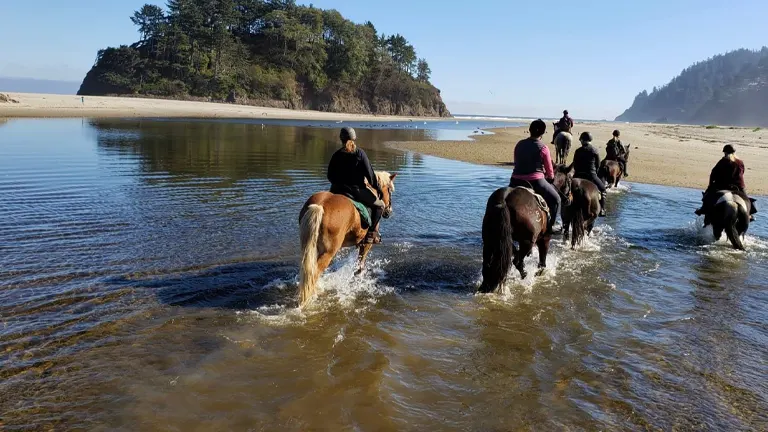
The Willamette Valley is a picturesque destination characterized by its rolling hills, vineyards, and vast open spaces. This fertile valley offers a serene backdrop for horseback riding, combining natural beauty with the charm of Oregon’s wine country.
- Location: Western Oregon, extending from Portland in the north to Eugene in the south.
- Size: The valley encompasses thousands of miles of trails through both public lands and private vineyards.
- How to Get There: The nearest major airports are Portland International Airport and Eugene Airport. The valley is easily accessible by car from these cities.
- Fees/Rental: Some vineyards and private estates offer horseback tours through their properties, with prices varying. Public trail access is often free or requires a minimal day-use fee.
- Best Time to Visit: Spring through fall, when the weather is mild and the landscapes are most vibrant.
- Suitable for: All levels. There are trails for casual rides as well as more challenging paths for experienced riders.
- Additional Tips: Many locations offer the unique opportunity to combine horseback riding with wine tasting, so plan accordingly for a leisurely day exploring the valley.
8. Gettysburg National Military Park, Pennsylvania
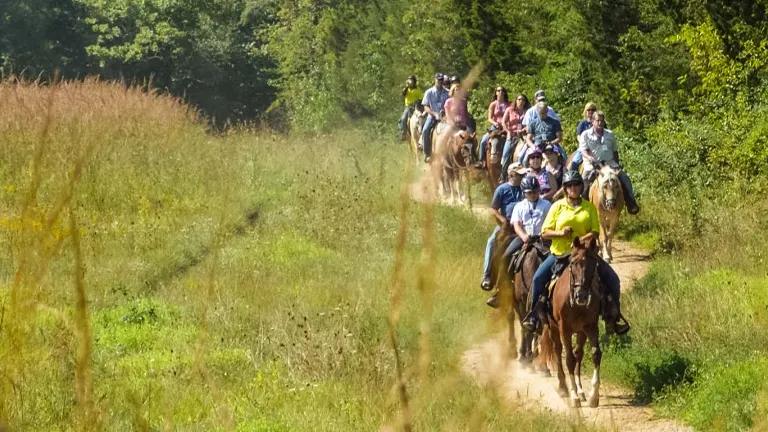
Gettysburg National Military Park offers a unique opportunity to combine history with equestrian adventures. Riders can explore the same grounds where the Battle of Gettysburg took place, offering a profound sense of the past amidst the park’s natural beauty.
- Location: Gettysburg, Pennsylvania.
- Size: The park covers approximately 6,000 acres, with several trails designated for horseback riding.
- How to Get There: The closest major airport is Harrisburg International. Gettysburg is accessible by car from major cities in the region, including Washington D.C., Baltimore, and Philadelphia.
- Fees/Rental: Horse rental and guided historical tours are available from local providers, with prices varying by length and group size.
- Best Time to Visit: Spring and fall offer the best weather for riding and exploring the historic site.
- Suitable for: Riders with an interest in history. The trails are suitable for all skill levels.
- Additional Tips: Be prepared for a more structured ride, as guides often stop at significant sites to offer historical context and stories.
9. Maui, Hawaii

Maui offers a tropical paradise for horseback riders, with trails that offer ocean views, volcanic landscapes, and lush forests. Riding in Maui is an unforgettable experience, showcasing the island’s diverse ecosystems and breathtaking natural beauty.
- Location: Maui, Hawaii.
- Size: Various trails across the island, from coastal paths to mountainous terrain.
- How to Get There: Kahului Airport is the main entry point, with direct flights from the continental US.
- Fees/Rental: Tours and rental prices range widely, starting from around $100 for a two-hour ride. Many operators offer unique experiences, such as beach rides and sunrise or sunset tours.
- Best Time to Visit: Year-round, though April through October typically offers the best weather for outdoor activities.
- Suitable for: All levels. Maui’s diverse terrain accommodates beginners looking for scenic, leisurely rides and experienced riders seeking more challenging adventures.
- Additional Tips: Don’t forget to bring a camera. The unique landscapes and ocean views are truly photogenic, capturing the essence of horseback riding in paradise.
10. Custer State Park, South Dakota
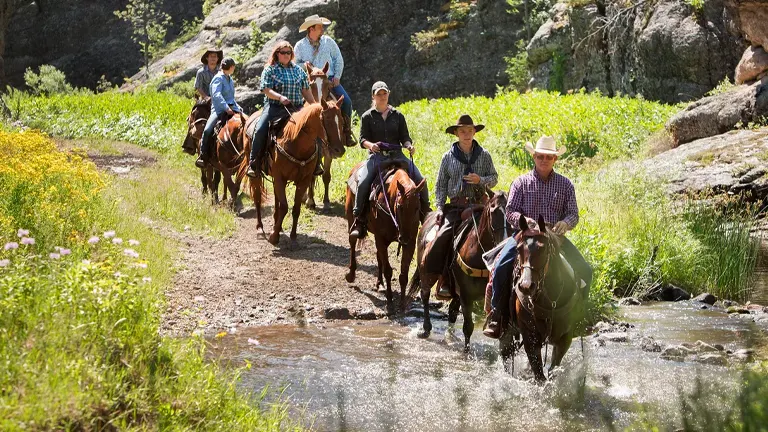
Custer State Park is renowned for its sprawling landscapes and abundant wildlife, offering riders the chance to explore the rugged beauty of the Black Hills. With over 71,000 acres of terrain, including rolling plains and granite peaks, horseback riding here is an immersive experience into the wild heart of South Dakota.
- Location: Black Hills, South Dakota.
- Size: Over 71,000 acres, with numerous trails specifically designated for horseback riding.
- How to Get There: The nearest airport is Rapid City Regional, about an hour’s drive from the park. Car rentals are available at the airport.
- Fees/Rental: Entry to the park requires a license, available for purchase at the entrance. Horse rental and guided tours are offered by local outfitters, with prices varying based on duration and group size.
- Best Time to Visit: Summer and early fall provide the best weather for exploring the park’s trails and wildlife.
- Suitable for: Riders of all levels, with trails ranging from easy scenic routes to challenging paths for the more adventurous.
- Additional Tips: Keep an eye out for the park’s famous bison herds, pronghorn antelope, and other wildlife. Always maintain a safe distance to respect their natural habitat.
11. Shenandoah National Park, Virginia
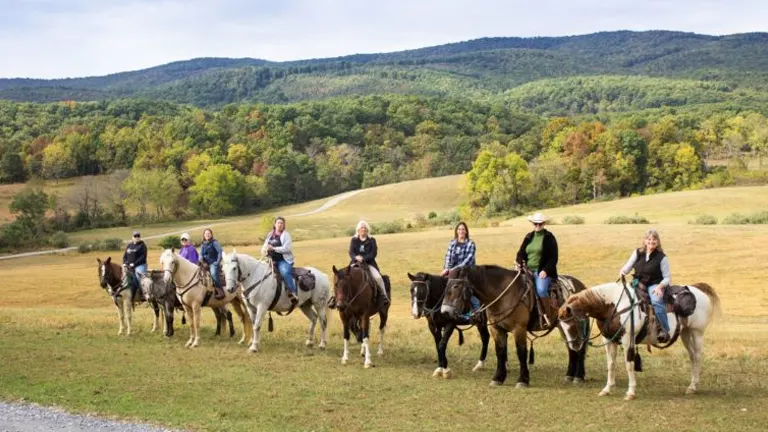
Shenandoah National Park is a haven for equestrians, with over 200,000 acres of protected lands that include lush forests, waterfalls, and a portion of the Appalachian Trail. The park’s elevated trails offer stunning views of the Virginia countryside, making it a picturesque location for horseback riding.
- Location: Virginia, along the Blue Ridge Mountains.
- Size: Over 200,000 acres, featuring more than 180 miles of trails open to horseback riding.
- How to Get There: The nearest major airports are in Washington D.C., about an hour and a half drive from the park. Car rental options are available at these airports.
- Fees/Rental: Entrance fees to the park are required, with additional costs for camping if you plan to stay overnight. While the park does not offer horse rentals directly, several local outfitters in the area provide horse rentals and guided tours.
- Best Time to Visit: Late spring through fall, when the park’s flora is in full bloom and the autumn leaves are changing, offers the most spectacular scenery.
- Suitable for: All experience levels. There are trails for gentle rides that are perfect for beginners, as well as more challenging routes for experienced riders.
- Additional Tips: Plan to visit during the week if possible to avoid the crowds that can gather on weekends and holidays, ensuring a more peaceful ride.
Planning Your Horseback Riding Adventure: Tips and Considerations
Preparing for Your Ride:
- Research: Before you set out, thoroughly research your chosen location. This includes understanding the terrain, weather conditions, and any specific rules or requirements (such as park fees or necessary permits).
- Equipment: Ensure you have the right gear for your ride. This typically includes a helmet, comfortable riding boots, long pants, and layers to accommodate changing weather. Most rental places offer helmets, but having your own can ensure the best fit and comfort.
- Skill Level: Choose a trail that matches your riding ability. Many of the locations listed offer options for beginners through to advanced riders, ensuring everyone has a safe and enjoyable experience.
During Your Ride:
- Stay Hydrated: Always bring water with you, especially in warmer climates or during longer rides. Some trails may not have water sources along the way.
- Respect Wildlife: Many of these destinations are home to diverse wildlife. If you encounter animals during your ride, keep a safe distance and do not attempt to feed or touch them.
- Leave No Trace: Preserve the natural beauty of these locations by following Leave No Trace principles. This includes packing out all trash, staying on designated trails, and minimizing your impact on the environment.
Maximizing Your Experience:
- Guided Tours: Especially for those visiting a park or trail for the first time, consider booking a guided tour. Guides can provide valuable insights into the area’s history, ecology, and best-kept secrets, enhancing your overall experience.
- Photography: These rides offer some of the most stunning landscapes you can find. Bring a camera or smartphone to capture the memories. Consider investing in a mount or strap to keep your hands free and your equipment secure while riding.
- Local Recommendations: Don’t hesitate to ask locals or your tour guides for recommendations on other activities or dining spots in the area. Exploring local cuisine or additional attractions can round out your trip beautifully.
Conclusion
Our exploration across the United States highlights the diverse and enriching horseback riding experiences available, showcasing spots that promise adventure, scenic beauty, and a deep connection with nature. These carefully selected locations stand out for their exceptional trails, accessibility for all skill levels, and unique landscapes, offering something special for every equestrian enthusiast. As you prepare for your horseback riding adventures in 2024, prioritize safety, respect for the environment, and an open heart for the new experiences awaiting. These destinations are not just places to visit but gateways to unforgettable memories and stories waiting to be discovered.
FAQs
- What should I pack for a multi-day horseback riding trip in one of these locations?
For multi-day adventures, pack lightweight, quick-dry clothing, a comfortable sleeping bag (appropriate for the season), a durable water bottle, high-energy snacks, sun protection, and a first-aid kit. Don’t forget essential horse gear and any specific items recommended by your tour operator, such as a helmet or riding gloves. - Can beginners participate in rides at all these locations, or are some exclusively for experienced riders?
All the locations featured offer trails or guided tours suitable for beginners. However, it’s crucial to communicate your skill level when booking so the guide can select the most appropriate path for your comfort and safety. - Are there any locations among the 11 that offer night riding experiences?
Night riding experiences depend on the specific location’s policies and available tours. Some locations may offer sunset or moonlight rides, providing a unique experience. It’s best to inquire directly with local stables or tour operators for the most accurate information. - What’s the best way to prepare physically for a horseback riding adventure if I’ve never ridden before?
To prepare, focus on core strength, flexibility, and overall fitness. Activities like yoga, pilates, and light cardio can improve your riding posture and comfort. Consider taking a few beginner riding lessons to familiarize yourself with the basics of horseback riding. - Are there any eco-friendly practices I should be aware of while exploring these locations on horseback?
Yes, always stick to marked trails to minimize environmental impact, pack out what you pack in, avoid feeding or disturbing wildlife, and use eco-friendly sunscreen and bug repellent. Select tour operators committed to sustainability and conservation efforts. - How do these locations accommodate riders with disabilities?
Many locations and tour operators offer adaptive riding programs or equipment to accommodate riders with disabilities. It’s essential to discuss your needs with the provider in advance to ensure they can offer a safe and enjoyable experience. - What unique wildlife might I see on these trails, and how should I respond if I encounter animals?
Depending on the location, you might see deer, bison, eagles, or even bears. Always maintain a safe distance, follow your guide’s instructions, and never attempt to feed or touch the wildlife. Your guide will provide specific advice for encounters with local fauna. - Is there a best season for horseback riding in these locations, considering the varied climates across the USA?
While many locations offer year-round riding, spring and fall are generally ideal for comfortable temperatures and scenic beauty. However, the best season can vary significantly by region, so check the specific climate and seasonal attractions of your chosen destination.
Explore our dedicated section on national forests and state parks to uncover hidden gems and outdoor wonders.
We’re excited to hear about your experiences exploring horseback riding spots across the USA! Feel free to share your stories, discoveries, and unforgettable moments below. Let’s come together as a community of equestrian enthusiasts and nature lovers, dedicated to experiencing and protecting the majestic landscapes of America’s countryside.

Benjamin Brooks
Forestry AuthorGreetings! I'm Benjamin Brooks, and my journey over the past 15 years has revolved around the fascinating realms of content creation, expertise in snow clearing, and the intricate world of lumberjacking and landscaping. What began as a simple curiosity about the natural world and heavy machinery has evolved into a passionate profession where my love for crafting words intertwines seamlessly with my lumberjacking and garden skills.













Leave your comment